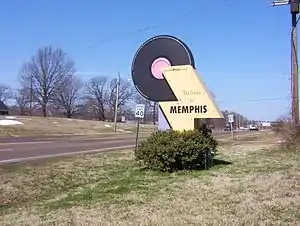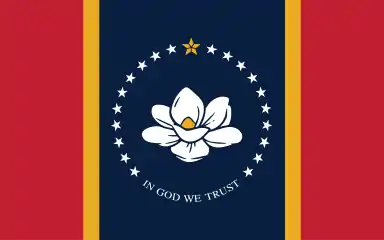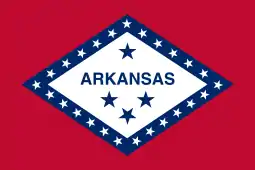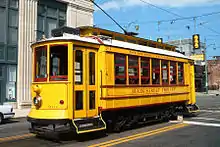Uptown, Memphis
Uptown Memphis is a neighborhood located near downtown Memphis, Tennessee. In 1999, the Uptown Partnership renamed the historic North Memphis Greenlaw neighborhood "Uptown" in concert with a public-private revitalization effort which defined Uptown as one hundred city blocks east of the Wolf River and North of A.W. Willis Avenue. The historic Greenlaw section of this neighborhood consists of the thirty city blocks closest to the Wolf River (this section is bordered by A.W. Willis Avenue to the south, North Seventh Street to the east, Keel Avenue and Chelsea Avenue to the north and the Wolf River to the west).
Areas adjacent to Uptown include St. Jude Children's Research Hospital and the Pinch District.
History
19th century
In 1856, Greenlaw Addition was laid out by William B. Greenlaw, John O. Greenlaw, Robert F. Looney, John L. Saffarans, Isaac Saffarans and E.T. Keel.[1] These men owned the land north of Memphis across Bayou Gaoyoso from downtown. The Bayou was the original northern boundary of the City of Memphis.
The thirty block subdivision extended the grid patterns of downtown Memphis and included many desirable features of the time such as cobbled streets, granite curbs, and boulevards lined with sycamore trees. The names of the founders are familiar as the east-west streets honor them: Greenlaw, Saffarans, Looney, and Keel. Mill Street was appropriately named due to the mills that occupied the adjacent riverfront.
The namesakes of this new addition, the Greenlaw Brothers, arrived in Memphis during the early days of the city's growth where they built open-air markets in the downtown. The other partners in the project were prominent Memphis Businessmen in the 1850s: Robert Looney operated a dry goods store, John Saffarans owned a building supply company and sawmill and E.T. Keel owned grocery stores and property.[2] Many of the original Greenlaw residents were also prominent Memphis businessmen and citizens while the remaining residents were construction tradesmen [3]
By the Civil War the area was prospering as remaining lots were being developed and businesses such as sawmills, brickyards and breweries were built on the banks of the Wolf River. In 1870, Greenlaw and Chelsea were annexed into Memphis.
Once Memphis recovered from the devastating effects of the Civil War, Greenlaw witnessed a major commercial and residential development.[4] Small neighborhood businesses concentrated along North Second Street as the area west of North Main became more industrial.[5] Residences included a mix of larger homes on prominent corner locations, smaller duplexes on the inside blocks and shotgun style homes on the alleyways and near the bayou. Originally named High Street, Seventh Street was the prime location for expensive homes due to its topographical advantage. Seventh Street follows the line of a Native American Trail running north and until 1867 it was the only bridge crossing Bayou Gayoso.[6] George Love, a former Mayor of Memphis, built a grand home on North Seventh Street in 1888, which is currently the city's Non-Profit Housing Center. Mr. Love also built investment properties to include four "Love cottages" on North Sixth Street in 1890 that have been recently renovated by Memphis Heritage, a preservation nonprofit.[7]
In its prosperous years, Greenlaw was inhabited by an ethnically and economically diverse population. First generation Irish, German, Jew and Italian immigrants and second generation Americans from the North and Midwest settled in the neighborhood.[8] By 1890, Greenlaw had a large African American population to include owners of neighborhood businesses and professionals living and working in the community.[9]
20th century
The 1912 Mississippi River Flood had a major impact on the Greenlaw neighborhood. It was at the epicenter of the flooding as indicated by four feet deep floodwaters at North Second Street and Mill Street;[10] 1,200 people fled as floods damaged over 714 homes and 25 manufacturing plants.
Gayoso Pumping station was built by the city in 1912 to prevent a recurrence but in 1913 the levee collapsed displacing over 1,000 families and covering twenty city block with water.[11] The Flood Control Act of 1917 proposed more additional levee construction but changes were no enacted until the 1930s as New Deal Construction projects to include permanent concrete box culverts, chamber, and pump stations.[12]
By the 1920s, many prominent and politically powerful families such as the Walshes, Loves and Guthries had moved out of the neighborhood. This population shift affected the city's support for the neighborhood; the Wolf River Bridge at the north end of Second Street was washed out in the 1930s and was never replaced. With the rapidly evaporating wealthy population, Greenlaw lost its political clout and its sense of being a "special" neighborhood.[13] Large homes were sold and often redesigned for more cost effective options such as apartments, rooming houses or business uses. Newly constructed homes were modest, designed to attract blue collar workers who would find the neighborhood convenient and affordable.[14]
With favorable geography and low property values, Greenlaw was a location of great industrial growth during World War II. By 1945, Philip Belz had built plants in North Memphis for General Motors, Bemis Bag, General Electric, Kroger, U.S. Rubber, and National Biscuit.[15] The neighborhood attracted blue-collar workers and African Americans. Bars, liquor stores and juke joints also opened up, tarnishing the family-friendly atmosphere.
In an effort to attract more white residents, the Memphis Housing Authority built an all-white housing development called Hurt Village in the 1950s.
Racial tensions were at a high in the 1960s due to the sanitation strike and assassination of Martin Luther King. Most whites who lived in Hurt Village left the area. Since then, most businesses have closed as well as industries. Non-profit groups seek ways to assist the mainly African-American residents left in the area.
21st century
In 2000, Memphis was awarded the Hope VI grant for demolition of Hurt Village. Uptown is currently becoming a mixed community that is rich in culture and people. The Blind Side took place here.
Notable residents
At one time, Elvis Presley lived in Lauderdale Courts, a small government housing project in this area which has since been renovated into a nicer apartment complex.Eric Boyce and family once lived there. Michael Oher, a player in the NFL, spent most of his childhood growing up in Uptown Memphis, until the Tuohy family took him in.
References
| Wikimedia Commons has media related to Uptown Memphis. |
- Keating, 1888
- Jemison, Dunaway & Kremer, 1979
- Jemison et al., 1979
- Jemison et al., 1979
- Jemison et al., 1979
- Griffin, 2001
- Davis, 2012
- Jemison et al., 1979
- Jemison et al., 1979
- Friends for our Riverfront, 2014
- Williams, 2008
- Williams, 2008
- Jemison et al., 1979
- Jemison et al., 1979
- Jemison et al., 1979
Davis, Chris. (2012).Warts & All. Memphis, TN: Memphis Magazine.
Friends for our Riverfront. (2014). Retrieved from the website: http://www.friendsforourriverfront.org/
Griffin, John. (2001). Repeating History. Memphis, TN, Memphis Flyer. Retrieved from:
http://www.memphisflyer.com/memphis/repeating-history/Content?oid=1106654
Jemison, P.B., Dunaway, V., & Kremer, R.A., (1979). Greenlaw Rediscovered a History. Memphis, TN: Metropolitan Inter-Faith Association (MIFA)
Keating, J. (1888). History of the City of Memphis Tennessee with illustrations and biographical sketches of some of its prominent men and pioneers. Syracuse, NY: D. Mason and Co. Publishers.
Williams, Bobby J. (2008). The Floods of 1912 and 1913. Memphis, TN. Shelby County Tennessee History and Genealogy. http://tn-roots.com/tnshelby/history/Floods.htm






